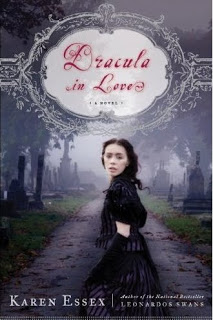In a Nutshell:
First of all, to keep things transparent, I was asked to write this review by Random House. I was absolutely honored and have enjoyed Karen Essex before, so it was a good fit for me. The funny thing is, I am not a “Dracula” kind of person. In fact, a review I wrote a few years back was on “The Historian” which was another Dracula book I could not stand. I also was a little skeptical regarding this book. With the whole “Twilight bandwagon”, I had to ask myself if Ms. Essex was just riding the coat tails of the trend? Well, I can tell you that this book is more about revisiting the original Dracula story than anything else, in a way that has never been done before. In way that was very provocative, creative and, well…dare I say…way sexy.
This book is based on the original story of Dracula written by Bram Stoker. But don’t assume too much here. Ms. Essex takes a completely different look at the story and turns certain things on it’s head for distinct reasons-but I will get to that below. So to be fair to the author, I decided to brush up on the original Dracula tale with some Spark Notes before I dove into Dracula in Love. It was well worth it, and I think I enjoyed the read even more because of it.
The original story of Dracula was a commentary on not only the modern world encroaching on the old, traditional world-thus making Victorian Society (i.e. men) very uncomfortable. But it was also a “watch out” to Victorian society for sexualized women. Beyond the horror and thrilling story of Dracula was a commentary on women-and that sexuality in women was dangerous. Sexualized, independent women could ruin a man’s life. As women began awakening to their “freedoms”, they were a threat to the steady, predictable fabric of acceptable society. Science and technology was also doing that-but women were as well. And they were easier to control as well as a perfect scapegoat for all this change. It is important to keep that in mind as you read this novel.
The cast of characters are the same, with Mina being the main character. Mina is a school teacher, engaged to the lawyer, John Harker. John Harker goes to close a real estate deal for a mysterious Count overseas, and that is where Harker meets the “she devils” that seduce him and as he says, try and kill him. There is also Lucy (Mina’s best friend) and Lucy’s ailing mother, as well as Lucy’s three suitors. There is also the legendary Dr. Von Helsinger, and of course, Count Dracula himself. The cast is the same, but their motives, actions and personalities are all different. The story is told solely by Mina. And even as she begins her story in her words she basically refers to the original story that we know as a sham, and plans to tell you the way in which things really happened.
“Unlike most people whose lives remain private, my story has been written by another, sold for money, and offered to the public for entertainment. The author of the fiction claims to be above reproach because his records are “exactly contemporary”. But these “records” are falsified documents, based on lies of a cabal of murderers desperate to conceal their dark deeds. The true story remains a secret–my secret–and with good reason. Reader, you are about to enter a world that exists simultaneously with your own. But be warned: in its realm, there are no rules, and there is certainly no neat formula to become–or destroy–one who has risen above the human condition. ” (prologue)
To that end, there is also a tertiary character, a sensationalist newspaper man, that is gently woven through the story. He is the character that perhaps causes the known Dracula horror story to grab hold, just to sell more papers. This helps gives reason as to why you would believe the tale you are now reading versus the last one by Stoker. Many of the major events unfold very similar to the original story, except that Lucy is not seduced by Dracula, nor does she become a vampire. Her tale is more real, more sad, and more true to what many women had to deal with during this time period. In sharp contrast is Mina’s story, complete with magic, mysticism, love and empowerment.
My Take:
It took me a little bit to get into, but let me clarify. Out of the gate, it grabs you at 100 miles an hour. Page one, Mina is sleepwalking and gets assaulted and almost raped in the first few pages of the book. The writing is so descriptive-the situation so horrible-that it is quite a fast paced page turner. Then things slow down for a bit after, particularly when Mina is in the quiet, seaside town of Whitby with Lucy. But when Mina goes to her fiance’s bedside overseas until the very end, things get really interesting. Toward the last half of the book, I pulled a couple of all nighters, it was so good I could not put it down! I love a read like that (though my dark circles don’t!) I really liked quite a few things about this book that give this novel merit in the halls of “Dracula” interpretations. First, it is very sexual. And it should be-considering that is what the main basis was for the original book of Dracula. Mina awakens to many things in herself, but especially to her sexuality. A few times, I needed a cold shower after reading. Some of the scenes in here were really sensual and erotic, yet beautifully written so that it did not feel like a cheesy romance novel.
But beyond the sex, I love that Dracula was not a monster, per say. He was still an immortal being, and the drinking of blood was a powerful thing that should only be shared with other immortals–or someone you wanted to become immortal by having the human drink the immortal’s blood. The latter is described as a very dangerous thing because most mortals can’t survive the transition and usually die. Dracula, though powerful and able to kill, only killed when he had to–mostly to protect Mina. Mina often refers to him as her “savior” and her “companion”. Dracula brought Mina to her real self, protected her, took care of her and awakened her freedoms and her sexuality. Bram Stoker was against much of this. In the original Dracula story, he made Mina an asexual being in his story and way too “Pollyanna“. She was “good” and a perfect example of the ideal Victorian woman. In contrast was Lucy, a flirtatious woman with three suitors, and admitted to wanting to marry all of them! Stoker kills her off because she gives into her sexual side by giving into Dracula-thus her more carnal desires.
This scenario was in need of refreshing. We all know now that women can be true to themselves, that it is healthy to be a sexual being and to rejoice in our freedoms. So who are the real monsters here? Victorian men who wish to squelch a woman’s spirit? Men that use them and prevent them from being who they are–or Dracula? Ahh, this is the paradox that Ms. Essex brings to life in a very gripping manner. I really liked how she turned this whole story upside down. The real monsters were most of the human men of this time period. When Mina (and Lucy) begin to show too much free thinking and independence-they become forced patients of the Bedlam insane asylum. It is here that Von Helsinger runs awful experiments. One such experiment is the infusion of male blood into women to make them (what he thinks) mentally superior and overall better. But without the knowledge of blood types, Von Helsinger kills Lucy because the blood they transfuse was incompatible. Ms. Essex writes the actual process in such a way that describes that this blood violation–this blood draining by these men–was the real crime here. For example, Lucy describes the blood experiment in her letter to Mina as she begs for help to escape:
“Von Helsinger…directing the men how to touch me…When Arthur isn’t taunting me, they are completely silent as they stroke and kiss me all over my body. I can hear their heavy breaths breaking the awful silence in the room. I cannot tell you the state of self-disgust this invokes in me. When Von Helsinger feels that my body is ready, he takes my naked arm and makes an incision into which he inserts a tube with a central rubber bulb for pumping. Then he rolls up the sleeve of my donor…” pg. 180
This experiment eventually killed Lucy. A sexual violation, and a blood transfer, but not Dracula. Something far worse and more sinister.
So if you are in the mood for a steamy, slightly “women’s lib” approach to the Dracula story with a little bit of fairy tale mixed in, than pick this book up! I found myself sad when the book ended, but I have a glimmer of hope that Ms. Essex is not done. There are elements in the ending that made it seem like there might be more to this saga. I hope so. I would like to visit Mina and her Count again. Thank you Random House for giving me the opportunity to read it. I am not sure I would have on my own, and it was worth it!
- Sugar-Free, Low-Carb, Olive Oil Chocolate Hazelnut Tart - February 18, 2023
- Easy Slow Cooker French Onion Soup - November 28, 2022
- Recipe: Chicken Vindaloo with Whole Foods Vindaloo Curry Powder - January 22, 2022





